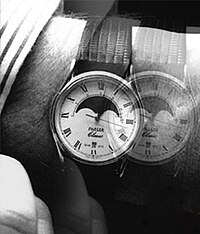
Photo from wikipedia
Optokinetic nystagmus (OKN), the reflexive eye movements evoked by a moving field, has recently gained interest among researchers as a useful tool to assess conscious perception. When conscious perception and… Click to show full abstract
Optokinetic nystagmus (OKN), the reflexive eye movements evoked by a moving field, has recently gained interest among researchers as a useful tool to assess conscious perception. When conscious perception and stimulus are dissociated, such as in binocular rivalry—when dissimilar images are simultaneously presented to each eye and perception alternates between the two images over time—OKN correlates with perception rather than with the physical direction of the moving field. While this relationship is well established in healthy subjects, it is yet unclear whether it also generalizes to clinical populations, for example, patients with Parkinson’s disease. Parkinson’s disease is a motor disorder, causing tremor, slow movements and rigidity. It may also be associated with oculomotor deficits, such as impaired saccades and smooth pursuit eye movements. Here, we employed short-duration, onset binocular rivalry (2 s trial of stimulus presentation followed by 1 s inter-trial interval) with moving grating stimuli to assess OKN in Parkinson’s disease patients (N = 39) and controls (N = 29) of a similar age. Each trial was either non-rivalrous (same stimuli presented to both eyes) or rivalrous, as in binocular rivalry. We analyzed OKN to discriminate direction of stimulus and perception on a trial-by-trial basis. Although the speed of slow-phase OKN was slower in the patients, discriminability of conscious perception based on OKN was comparable between the groups. Treatment with anti-Parkinson drugs and deep brain stimulation improved motor ability of patients, but did not impact on OKN. Furthermore, OKN-based measures were robust and their latencies were shorter than manual button-based measures in both groups and stimulus conditions. To our knowledge, our study is the first to demonstrate that OKN can be used as a reliable indicator of conscious perception in binocular rivalry even in Parkinson’s disease patients in whom impaired manual dexterity may render button-press reports less reliable.
Journal Title: PLoS ONE
Year Published: 2017
Link to full text (if available)
Share on Social Media: Sign Up to like & get
recommendations!